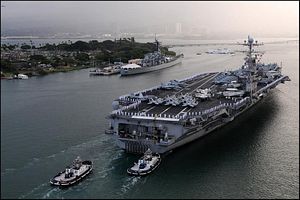Over at The National Interest this week, former Naval Diplomat shipmate — U.S. Marines say there are no former Marines, just Marines; are there former shipmates? — Bryan McGrath wades into the debate over Tom Ricks’s Washington Post column urging the U.S. military to get smaller to get better.
Let me wade in as well; the water’s fine. Ricks takes aim at the U.S. Navy’s fleet of nuclear-powered aircraft carriers in particular. He cites the expense of CVNs, but Bryan zeroes in mainly on the question of flattops’ vulnerability in a threat environment populated by exotic armaments such as anti-ship cruise and ballistic missiles, stealth tactical aircraft, and so forth.
Bryan mocks Ricks’ observation that CVNs look much like their distant ancestors. But the point is that carriers have enormous radar cross-sections. They don’t have that sleek, angular, unearthly appearance that typifies stealth aircraft and ships. Radar essentially shouts and listens for the echo. A bulky hull featuring lots of flat surfaces, sharp edges, and protuberances is bound to reflect electromagnetic radiation — the shout — returning that echo to the adversary’s radar set and thence to his fire-control system and anti-ship weaponry. In that sense, the look of a ship does matter, as Ricks observes.
The game’s afoot once the ship is detected. To delay detection and targeting, shipbuilders have incorporated gee-whiz measures into the design of the Gerald R. Ford, the U.S. Navy’s latest supercarrier. Cutting down on its RCS helps. Still, short of conducting a true-to-life Philadelphia Experiment on a grand scale, there’s only so much you can do to disguise a 100,000-ton behemoth. While it represents the vanguard of carrier technology, no one would describe even the Ford as intrinsically elusive.
Bryan recalls, rightly, that this is far from the first time carriers and air wings have faced mortal threats. Just Google USS Franklin and be amazed that flattop limped back from the Pacific to New York after absorbing bomb strikes and heavy casualties off Japan. Other ships were less fortunate.
He also observes that the carrier fleet adapted to past dangers. True, but that’s where we really part company in this debate. While the carrier and its aerial contingent have evolved with the threat, by no means do technological and tactical innovations “guarantee the aircraft carrier’s utility,” as he contends. Sure, journals back during the Cold War played up supposedly carrier-killing technologies. Mariners of a certain, ah, age were marinated in the idea that Backfire bomber raids featuring fusillades of missiles were coming out to smite us if we ventured within reach. Faces were oftentimes long.
And yet it’s possible, and indeed commonplace, to take the fact that the Cold War ended on American terms too far. We won, the Soviets lost, to borrow from President Reagan. Huzzah! Let’s take a victory lap!! But did the U.S. Navy really beat the Soviet maritime threat, as Bryan and kindred navalists opine? How would we know?
Bernard Brodie, who ranks among the 20th century’s premier strategists, spotlights the perils of this way of thinking. Ships, as Corbett notes, are the material expression of whatever strategic and tactical ideas happen to be in vogue at the time. Writing during World War II, Brodie maintained that one reason the carrier supplanted the battleship in world fleets was because decisionmakers thought it ought to. If you build lots of one type of capital ship and few of another, guess which type is likely to predominate in naval actions? A kind of circular logic, then, is at work. The aircraft carrier is dominant because important people tell themselves so.
More to the point, Brodie cautions against drawing sweeping, hard-and-fast conclusions from fleet duels. He notes that “major fleet actions are few and far between even as centuries are reckoned.” Less than a year from now the U.S. Navy will mark the 70th anniversary of its last such engagement, at Leyte Gulf in October 1944. Yet “such a battle would be presumed to have settled the matter conclusively for the age in which it occurred.”
Any statistician will tell you it’s a fallacy to generalize from a single datapoint. Reading too much into a sample size of one is hazardous, agrees Brodie, because changing a few variables might have changed the complexion of a battle significantly — prompting posterity to draw far different, equally confident conclusions about naval warfare from substantially the same facts. Because “there are too few naval wars and too few major naval battles to prove the correctness of a tactical theory,” observers tend to let the “pragmatic test of victory” substitute for testing the hypothesis across a broad range of historical cases. In other words, we assume that whoever won must’ve gotten the tactics and hardware right.
Whoa. If extrapolating from a sample size of one or a few is suspect, try extrapolating from a sample size of zero. The Cold War ended without a Leyte Gulf, a high-seas action that post-Cold War generations could study. We never put the hypothesis that carrier task forces could withstand Soviet attacks to the only test that counts: combat. That being the case, debates over flattops, carrier aircraft, and anti-ship arsenals rage in a kind of Neverland where we can compare hardware but don’t know for sure how a clash would unfold in a particular strategic setting.
So let’s not be too quick to claim that carriers have kept pace with the threat up until now and will keep doing so, forever and ever, amen. Projecting the past into the future is risky business — especially when we’re unsure what that past was.

































